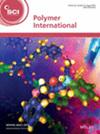求助PDF
{"title":"Thermal decomposition analysis and combustion mechanism investigation of biomass-based polyurethane","authors":"Zhirong Xu, Jing Zhan, Zihui Xu","doi":"10.1002/pi.6739","DOIUrl":null,"url":null,"abstract":"<p>Starch phosphate carbamate was synthesized via a one-pot method using phosphoric acid, urea and starch, and it was added into polyurethane (PU) to replace some polyol. The fire retardancy and thermal stability of the resulting PU system were evaluated by the results of vertical burning test (UL-94), limiting oxygen index (LOI), cone calorimeter (CONE) test and thermogravimetric analysis. Raman spectroscopy and X-ray photoelectron spectroscopy were used to analyze the char layer after the CONE test, and the thermogravimetric–infrared test was used to analyze the gas products at the maximum rate of thermal decomposition. The introduction of 13.7 wt% starch phosphate carbamate (PU-15) in PU enables the system to pass the V-0 rating, with LOI reaching 22.8%. The peak heat release rate of PU-15 decreased by 36.54% compared to PU, and the total heat release of PU-15 was only 27.87 MJ m<sup>−2</sup>. Starch phosphate carbamate reduces the generation of combustible small molecules during the combustion of the system, producing a more protective char layer. Raman results indicate that starch phosphate carbamate can increase the stability of the char layer. Integrating the results from various tests, the combustion mechanism of PU with starch phosphate carbamate was explored. Starch phosphate carbamate provides a new approach for preparing high-performance PU. © 2024 Society of Chemical Industry.</p>","PeriodicalId":20404,"journal":{"name":"Polymer International","volume":"74 7","pages":"575-582"},"PeriodicalIF":3.6000,"publicationDate":"2024-12-26","publicationTypes":"Journal Article","fieldsOfStudy":null,"isOpenAccess":false,"openAccessPdf":"","citationCount":"0","resultStr":null,"platform":"Semanticscholar","paperid":null,"PeriodicalName":"Polymer International","FirstCategoryId":"92","ListUrlMain":"https://scijournals.onlinelibrary.wiley.com/doi/10.1002/pi.6739","RegionNum":4,"RegionCategory":"化学","ArticlePicture":[],"TitleCN":null,"AbstractTextCN":null,"PMCID":null,"EPubDate":"","PubModel":"","JCR":"Q2","JCRName":"POLYMER SCIENCE","Score":null,"Total":0}
引用次数: 0
引用
批量引用
Abstract
Starch phosphate carbamate was synthesized via a one-pot method using phosphoric acid, urea and starch, and it was added into polyurethane (PU) to replace some polyol. The fire retardancy and thermal stability of the resulting PU system were evaluated by the results of vertical burning test (UL-94), limiting oxygen index (LOI), cone calorimeter (CONE) test and thermogravimetric analysis. Raman spectroscopy and X-ray photoelectron spectroscopy were used to analyze the char layer after the CONE test, and the thermogravimetric–infrared test was used to analyze the gas products at the maximum rate of thermal decomposition. The introduction of 13.7 wt% starch phosphate carbamate (PU-15) in PU enables the system to pass the V-0 rating, with LOI reaching 22.8%. The peak heat release rate of PU-15 decreased by 36.54% compared to PU, and the total heat release of PU-15 was only 27.87 MJ m−2 . Starch phosphate carbamate reduces the generation of combustible small molecules during the combustion of the system, producing a more protective char layer. Raman results indicate that starch phosphate carbamate can increase the stability of the char layer. Integrating the results from various tests, the combustion mechanism of PU with starch phosphate carbamate was explored. Starch phosphate carbamate provides a new approach for preparing high-performance PU. © 2024 Society of Chemical Industry.
生物质基聚氨酯的热分解分析及燃烧机理研究
以磷酸、尿素和淀粉为原料,采用一锅法合成了淀粉氨基甲酸酯磷酸酯,并将其加入聚氨酯(PU)中代替部分多元醇。通过垂直燃烧测试(UL-94)、极限氧指数(LOI)、锥形量热仪(cone)测试和热重分析,对所得聚氨酯体系的阻燃性和热稳定性进行了评价。采用拉曼光谱和x射线光电子能谱对CONE测试后的炭层进行分析,采用热重-红外测试对最大热分解速率下的气体产物进行分析。在PU中加入13.7 wt%的淀粉氨基甲酸酯(PU-15),使体系通过V-0等级,LOI达到22.8%。与PU相比,PU-15的峰值放热速率降低了36.54%,总放热速率仅为27.87 MJ m−2。淀粉磷酸盐氨基甲酸酯减少了燃烧过程中可燃小分子的产生,产生了更具保护性的炭层。拉曼光谱结果表明,氨基甲酸淀粉能提高炭层的稳定性。综合各项试验结果,探讨了聚氨酯与氨基甲酸淀粉的燃烧机理。氨基甲酸淀粉为制备高性能聚氨酯提供了新的途径。©2024化学工业学会。
本文章由计算机程序翻译,如有差异,请以英文原文为准。




 求助内容:
求助内容: 应助结果提醒方式:
应助结果提醒方式:


